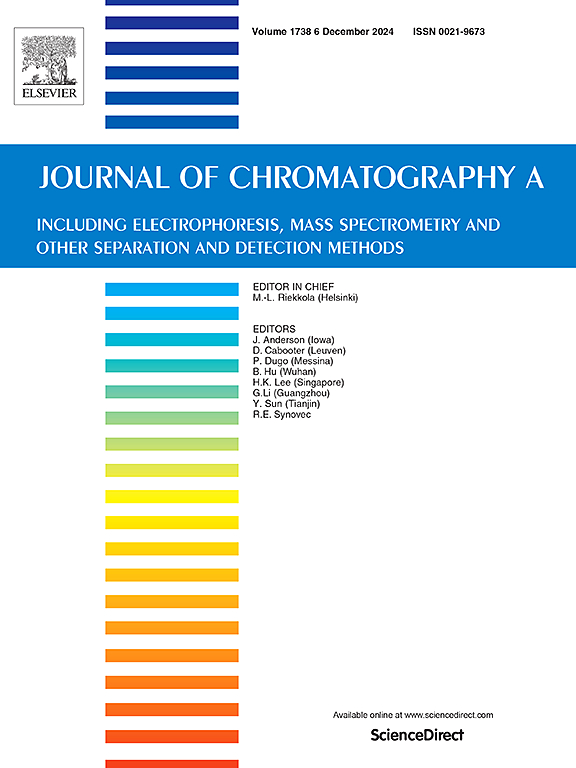Multi-detector based at-line nanofractionation strategy accelerates discovery of influenza PA endonuclease inhibitors from Terminalia chebula Retz
IF 4
2区 化学
Q1 BIOCHEMICAL RESEARCH METHODS
引用次数: 0
Abstract
The highly conserved N-terminal domain of polymerase acidic endonuclease (PAN) makes it an attractive target for the development of anti-influenza virus drugs. This study developed an innovative multi-detector based at-line nanofractionation platform by coupling an HPLC system containing triple-detector (diode array detector (DAD), charged aerosol detector (CAD) and MS) with fluorescence resonance energy transfer (FRET)-based bioassays to systematically identify potential PAN inhibitors from traditional Chinese medicine (TCM). A preliminary screening of 230 TCM extracts revealed an exceptional PAN inhibition by Terminalia chebula Retz. (IC50 = 0.88 μg/mL). A time-resolved FRET bioassay in 384 well-plates with parallelized MS/MS analysis enabled real-time acquisition of both biological activity profiles and chemical information from Terminalia chebula Retz. extracts. HPLC-DAD-CAD analysis further elucidated the correlation between the content and bioactivity of the identified potential PAN-inhibitory compounds, addressing the limitations of traditional single UV-based detection. Remarkably, 31 bioactive compounds (including gallotannins, ellagitannins, and phenolic acids) were identified through this approach, with 75.9% exhibiting low abundance (CAD response < 1 pA·min), highlighting the unique capability of this platform in discovering low-abundant bioactive entities. Five verified compounds (ellagic acid, chebulinic acid, punicalagin, chebulagic acid, and 1,3,6-tri-O-galloyl-β-D-glucose) exhibited superior PAN inhibition (IC50 = 0.52-1.00 μM) in comparison to baloxavir marboxil (IC50 = 10.83 ± 1.46 μM). A molecular docking study elucidated their crucial PAN-binding interactions and fundamental mechanisms. Overall, this study not only identified several potential PAN inhibitors from Terminalia chebula Retz., but also offered a scalable at-line nanofractionation strategy to reveal the content-activity correlation of complex TCM extracts.
基于多检测仪的在线纳米分离策略加速了从chebula Retz中发现流感PA内切酶抑制剂
聚合酶酸性核酸内切酶(PAN)高度保守的n端结构域使其成为抗流感病毒药物开发的一个有吸引力的靶点。本研究通过将包含二极管阵列检测器(DAD)、带电气溶胶检测器(CAD)和MS)的高效液相色谱(HPLC)系统与基于荧光共振能量转移(FRET)的生物测定相结合,开发了一种创新的基于多检测器的近线纳米分离平台,以系统地鉴定中药(TCM)中潜在的PAN抑制剂。通过对230种中药提取物的初步筛选,发现终叶对PAN具有明显的抑制作用。IC50 = 0.88 μg/mL)。在384个孔板上进行时间分辨FRET生物测定,并行MS/MS分析,实时获取chebula Retz的生物活性谱和化学信息。提取物。HPLC-DAD-CAD分析进一步阐明了鉴定的潜在pan抑制化合物的含量与生物活性之间的相关性,解决了传统的单紫外检测的局限性。值得注意的是,通过这种方法鉴定出31种生物活性化合物(包括没食子丹宁、鞣花丹宁和酚酸),其中75.9%表现出低丰度(CAD响应<; 1 pA·min),突出了该平台在发现低丰度生物活性实体方面的独特能力。与baloxavir marboxil (IC50 = 10.83±1.46 μM)相比,5个经验证的化合物(鞣花酸、chebulagic酸、punicalagin、chebulagic酸和1,3,6-三- o -没食子酰-β- d -葡萄糖)具有更好的PAN抑制作用(IC50 = 0.52-1.00 μM)。分子对接研究阐明了它们关键的泛素结合相互作用及其基本机制。总的来说,本研究不仅从chebula Retz中发现了几种潜在的PAN抑制剂。同时,还提供了一种可扩展的在线纳米分离策略,以揭示复方中药提取物的含量-活性相关性。
本文章由计算机程序翻译,如有差异,请以英文原文为准。
求助全文
约1分钟内获得全文
求助全文
来源期刊

Journal of Chromatography A
化学-分析化学
CiteScore
7.90
自引率
14.60%
发文量
742
审稿时长
45 days
期刊介绍:
The Journal of Chromatography A provides a forum for the publication of original research and critical reviews on all aspects of fundamental and applied separation science. The scope of the journal includes chromatography and related techniques, electromigration techniques (e.g. electrophoresis, electrochromatography), hyphenated and other multi-dimensional techniques, sample preparation, and detection methods such as mass spectrometry. Contributions consist mainly of research papers dealing with the theory of separation methods, instrumental developments and analytical and preparative applications of general interest.
 求助内容:
求助内容: 应助结果提醒方式:
应助结果提醒方式:


